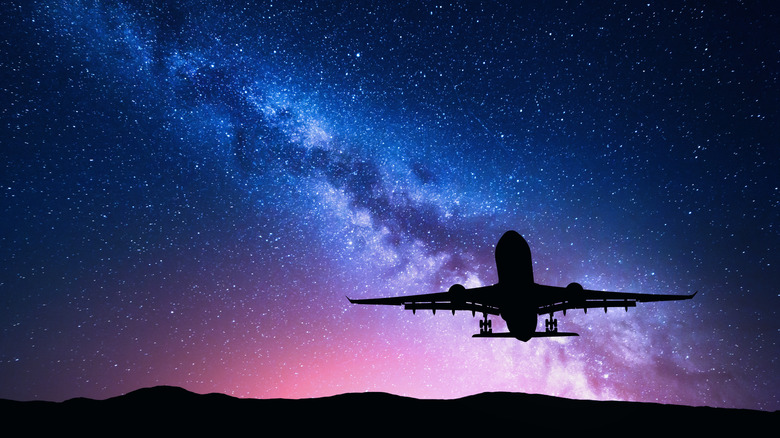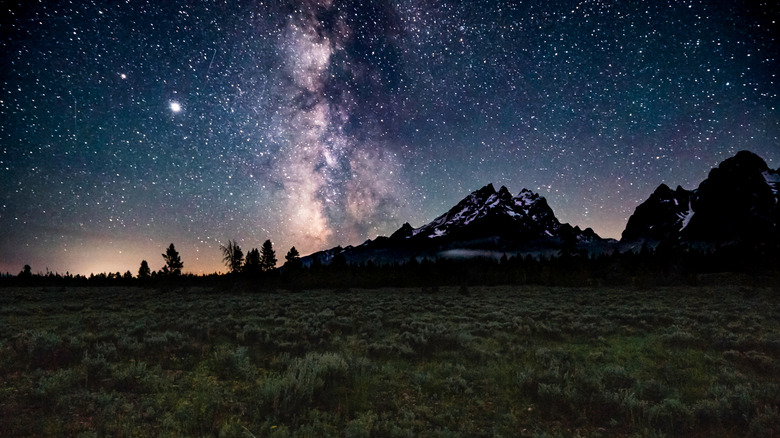The Only Airport Inside A National Park Is Now The World's First DarkSky Certified
If you can't tell the difference between a shooting star and an airplane, you might be in Jackson Hole. Located in Grand Teton National Park, Jackson Hole Airport (JAC) is the only airport inside a national park, and in April 2025, it became the first airport to be officially recognized as an Urban Night Sky Place. The certification was issued by DarkSky International, formerly known as the International Dark-Sky Association, whose mission is to preserve the natural night sky and reduce the impact of light pollution on communities and wildlife.
If you think about it, airports and light pollution often go hand in hand. Not only is extensive lighting needed to illuminate large runways and passenger infrastructure, but airports are often located miles away from central urban environments, in areas that are more likely to support wildlife. A study published in PeerJ by researchers at the Kyiv Aviation Institute concluded that light pollution is one of the most significant environmental impacts of airports, as it can provoke negative biological effects on wildlife.
Of course, all airports must meet Federal Aviation Administration safety standards, so there's no need to worry about a pitch-black landing. Still, this exciting new recognition has important implications for JAC and any other airports that may follow its lead.
What does it take to be DarkSky certified?
Jackson Hole may be the first airport to be recognized as an Urban Night Sky Place, but it joins the ranks of other certified locations like Arizona's underrated Saguaro National Park and wildlife refuges such as Valle de Oro. Qualifying for the designation is a lengthy process that could take anywhere between one and three years. First, the destination hoping to earn the recognition must make an initial inquiry, then follow guidance on how to meet the program's technical requirements. Applications must detail comprehensive lighting policies, plans to implement dark-sky-friendly methods, an outreach and education program, and a strategy for night sky monitoring.
Beyond the environmental benefits and a reduction in light pollution, DarkSky Certifications bring many other perks to local communities, such as increased visitor numbers as astrotourists discover new star-friendly destinations. The DarkSky standards also promote sustainability and safety by implementing technology that saves energy and reduces glare.
What does the certification mean for Jackson Hole Airport?
Jackson Hole Airport pulled out all the stops to obtain a DarkSky certification. "JAC staff has dedicated hundreds of hours to updating lighting fixtures and programming to adhere to responsible lighting practices," the hub noted in a press release. The project was a part of its Lighting Management Plan (LMP), which involved replacing both interior and exterior lights with DarkSky-compliant fixtures. It also required changing the manner in which lights are used to ensure they only operate when necessary and at appropriate levels. Shelters, motion sensors, and timers are also tools used to help control outdoor lighting. The color temperature of the light is managed as well, but generally, the biggest difference the average traveler will notice is how many more stars are visible in the skies above and around the airport.
This is just one of the many environmental efforts taken on by JAC, which also earned a LEED Silver Certification in 2011 and a Business Emerald Sustainability Certification (BEST) in 2019. If you want to know where else you might find gorgeous night skies, consider a trip to Utah, the American state with more DarkSky-certified stargazing spots than anywhere else.


